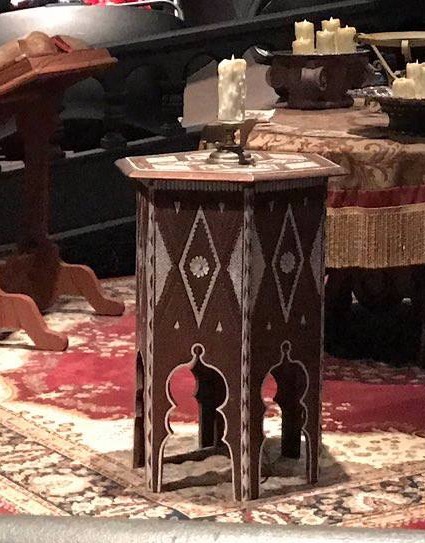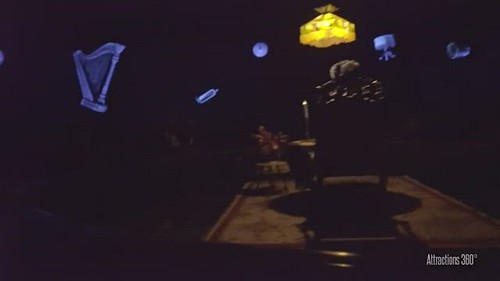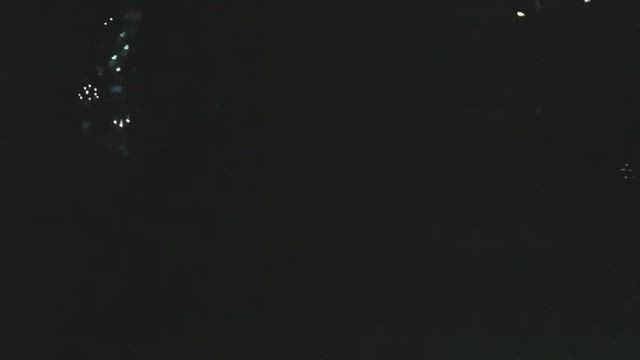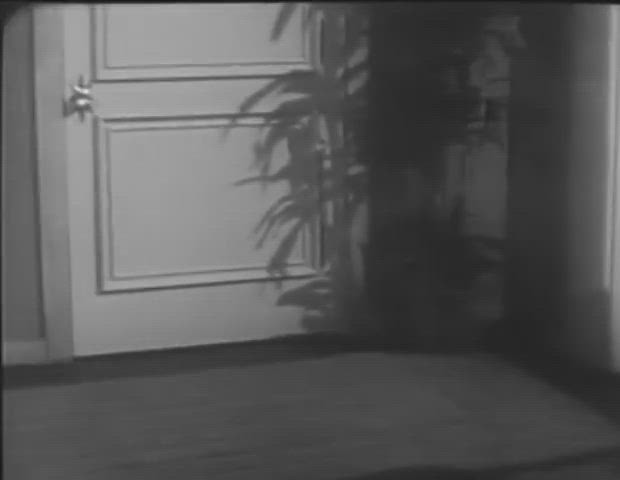(That's rap, kids, like, you know, when hippies say "rap." Never mind. Boomer thing.)
The germ of this post actually goes back to October of 2012. At the time I didn't think it was worth an independent post, so I tabled it. Since then enough new interest and new information has accumulated to change my mind.
This is one of those studies that focuses on an insignificant detail in the Mansion which, upon examination, turns out to be . . . okay, an insignificant detail. Actually I prefer to think of it as the tip of an interesting iceberg. The detail in question is a small table in the Séance Circle, located on the same levitating carpet occupied by Leota's table, chair, and (since 2005) spell book stand. It's always been there.
(Close up from a Daveland photo found here)
In the past, I've usually referred to it as a "scrying table," which is probably not the most accurate description. While it isn't exactly wrong, it isn't exactly right either. You'll soon see why. And speaking of "why" questions . . .
Why is it there? and Why is it there?
I suspect that its original purpose was to house the projector for the "Leota effect." I don't have any proof of this, but the reason I tend to think so is that it looks like the little table originally stood almost directly in front of her, to judge by these old photos:
You will recall that up until just a few months before opening day, the plan was to have Leota facing the opposite direction. You would see her face as you entered the room, and her projector was going to be in the cabinet directly behind her, which is still there. As we've pointed out before, you can see this earlier arrangement in photos of the scale model the Imagineers made:
When the plans were changed (a big improvement, I think), the immediate question must have
been, Where do we put the projector now? It ended up well out in front of her, below the railing.
(It's that black thing sticking up out of the floor.)
The thing to bear in mind is that all of these arrangements were incredibly rushed during the chaotic months of spring and early summer 1969, and it may well be that at first they expected to put the projector closer to the Madame, in which case they would need a piece of furniture to hide it in. Otherwise, I can't see any reason for including the little table to begin with, nor placing it where they did. I don't see it in any of the scale model photos.
If I'm wrong about this, it doesn't matter all that much. It could be that the only answer to the "why" question is that they found the little table somewhere, thought it looked cool, and plopped it in.
It does have a function in that it's got a candle on it, but for most of its existence the table top was bare. The candle only appeared in January of 2005, when they put in the Spell Book and some fancy new candles on the main table. That's also when its legs were lengthened, presumably because it now has something inside of it. A speaker, I imagine.
Okay, but what is it, exactly? It's a relic from the Victorian era, an antique, like many of the incidental furnishings in the Mansion. Antique dealers refer to them as "Moroccan side tables" (or "end tables"). They also call them "Moorish," "Turkish," "Ottoman," "Syrian," "Anglo Indian" and "Arabesque." Google any of those terms plus either "end" or "side" table, and you'll find hundreds of examples. It turns out that the one in the Disneyland Mansion is actually one of the most common varieties, although there are myriads of differences between them.
I'm sure the Halloween colors didn't hurt.
Here, I did all the work for you. Feast your eyes.
More Rockin' Side Tables
The sun never set on the Union Jack back in the days of Queen Victoria, and there was a bottomless appetite for quaint and curious items drawn from the farthest reaches of the British Empire, including and perhaps especially the "mysterious East." These handsome little tables, with their inlaid mother-of-pearl and intricate geometry, were charming conversation pieces, exotic imports from remote "Mahometan lands." You can spot them in paintings and photos of oh-so-artsy Victorian interiors:
So you're looking at a piece of authentic Victoriana, something you might find in any well-to-do house of the era, especially if the owners had a taste for the exotic and mysterious, so it's hardly surprising to find something like that in the Haunted Mansion. In the middle of 1969, someone probably found it in a local antique store for a decent price and grabbed it for the Séance Circle projector cover (if my guess is correct). When they decided not to project the Leota image from such close range, they kept the table anyway.
Do You Believe in Magic?
It's got something else going for it, making it an appropriate choice for the Séance room. If you looked carefully at the examples above, I'm sure you noticed that many of them have hexagrams on their tops, including the one in the Mansion.
I imagine that any Victorian interested in spiritualism and magic might have associated this six-pointed star with the "Seal of Solomon"—a symbol
well-known to students of the occult—and so would have coveted one of these babies that much more, perhaps for use as a scrying table.
Some readers may be smiling sardonically at this point. Surely these hexagrams and other polygonal shapes are merely examples of the sort of geometrical decoration found everywhere in Islamic architecture? Part of what makes these tables look like little buildings, in fact? And besides, look how many of these tables don't have a hexagram on them. In fact, look how many of the them are not hexagonal at all, but octagonal.
I hear you, but I wouldn't be too quick to label someone who sees the "Seal of Solomon" here as over-imaginative. The Muslim world, from whence these tables came, was just as agreeable to supernaturalism as the parlor of any 19th century Spiritualist, and strange as it may seem, the "Seal of Solomon" enjoyed and continues to enjoy a far more conspicuous presence in Islam than in Judaism or Christianity. Although there is plenty of evidence for decorative use of the hexagram in pre-Islamic Jewish and Christian sources, its use as a magical symbol, including its association with Solomon, is thought by most scholars to be a medieval import from the Arab world. You find it all over the place in Islamic iconography, on rings, medallions, talismans, coins, and even in architecture.
There are a gazillion rings like this one out there.
A talisman
Moroccan coin from 1873/4; that's the same time and place that many of these tables come from.
(Many of our tables have a distinctive decoration in the center. It's probably something
written in heavily stylized Arabic calligraphy. Sure would be fun to know what it says.)
In other words, it is not at all ridiculous to suppose that at least some of these table makers saw a spiritual and even magical significance in their designs. In fact, I would go so far as to suggest that it may be nothing more than Western prejudice to assume that hexagrams and other polygonal forms were ever "merely geometrical decoration" within the world view of these Middle Eastern craftsmen.
It's all academic anyway, since we have evidence that the tables did indeed have a vaguely magical aura about them in the eyes of Victorians, and Edwardians too, and they continue to be regarded that way even by some people today, regardless of whether anybody "should" so see them.
and become a stage magician, only to die very young, before his new career had a chance to take off.
Hey, if they're good enough for the Prince of Magicians, I say they're good enough for Madame Leota.
October 1972 (From a photo at Davelandweb)
As for Edwardians, there was a short story in the Oct 2, 1909 issue of the Saturday Evening Post called "The Nth Power," by Arthur Train, about a mysterious gentleman who was a master clairvoyant, telepath, and hypnotist. He's even got a crystal ball hanging over his dining room table, but all of it is quite "scientific." At one point he places a candle on a small table between himself and the narrator and so begins the process of putting him into a bizarre and nearly disastrous trance. When illustrator Alonzo Kimball rendered the scene, he knew what kind of table to draw:
Hat Tip: Craig Conley
And if you want evidence that these tables still look magical to modern eyes,
I will point out that you can buy new "scrying tables" and altars online . . .
. . . that are transparently modeled after Moroccan designs from the Victorian era:
In the end, the point is quite simple. These side tables from the Victorian era kinda sorta have a magical feel to them, and apparently always have, and that's probably why it just felt right to put one at Madame Leota's disposal. I mean, really, has anyone ever said that it looks out of place? And as a fan of the Haunted Mansion and admirer of its detailed artistry, you'll never look at this particular item in quite the same way again, now will you? I rest my case.
The Others
It remains to give some account of the tables found in the other Mansions. For some reason, the WDW HM also had a small table in its Séance Circle from the beginning, even though by 1971 there was surely no thought of putting a projector in it. In contrast to DL, it was a modest, normal-looking table, with flowers:
During the 2007 "Rehaunting," the table was traded out for a Moroccan side table like the one in Anaheim.
According to production designer Neil Engel, who installed it, they found the table at a swap meet.
According to production designer Neil Engel, who installed it, they found the table at a swap meet.
Another example of unnecessary Disneylandification in the Orlando Mansion, some would say.
Tokyo Disneyland, with characteristic conservatism, continues to utilize a very ordinary table in their Séance:
Phantom Manor, on the other hand, has always had a Moroccan end table. Like Orlando's,
it's a different type, but pretty close Victorian counterparts to it are not hard to find:
it's a different type, but pretty close Victorian counterparts to it are not hard to find:
That's more than enough about that topic, I should think.
************



































































